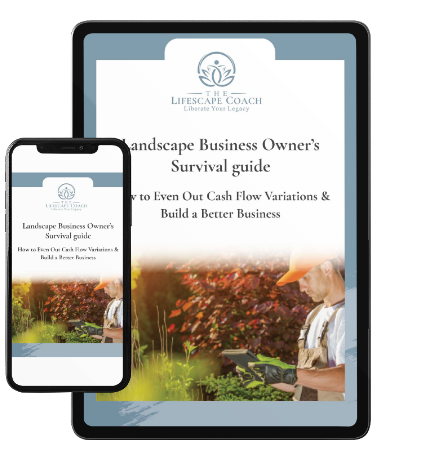Goal-Setting: A Landscape Business Growth Imperative for Success
Let’s face it: goal-setting is easier said than done. Remember all those New Year’s resolutions in the past that fell by the wayside in a matter of days? Or at least by the time the spring madness hit.
A major stumbling block for even the most well-intentioned goal-setting effort is that we tend to look in the wrong direction for inspiration. We focus outward, looking at other people and companies and things that we think are desirable. But these bright, shiny objects are distractions, not inspirations.
By focusing on something other than ourselves and the unique issues and situations we are facing in business, we put greater value on those external things, diminishing ourselves in the process. As a result, we risk not addressing the flaws or deficiencies that we should be addressing, layering more goals and to-do’s on top of what already exists and compounding the original issues.
It’s sort of like trying to repair a cracked concrete patio by simply adding more concrete on top of the already-flawed surface. Instead of fixing the underlying problem, you’ve just added another layer on top of it. Anyone who’s worked with concrete knows...the cracks migrate right up through the new overlay - and it happens pretty fast.
So what should you be doing to realistically set – and achieve – goals? Here are three tips:
1. Focus on three critical things within your organization
Ignore the bright, shiny objects – instead take a close look at yourself and your business. Take a moment with this exercise as a way to gather data to use in powerful goal-setting:
- What makes you uncomfortable? Are there certain clients, vendors, employees, job types, or situations that make you uncomfortable? Determine what relationships or processes need to change to minimize that discomfort.
- What frightens you? Did you avoid opportunities because you were afraid you would fail? Figure out how to learn from that fear and move beyond it – through either skill-building, or hiring, or partnering, for example – because when you lean into fear as a tool it begins to have less and less power over you. And you will be surprised by how easily you will also eliminate discomfort.
- What is your number one excuse? Making excuses enables us to avoid responsibility, and you can’t move forward until you take 100 percent responsibility for your actions and progress (or lack of it). Can you list what your go-to excuses are? Eeeek, I know...talk about discomfort. The reason for doing this is that you need to shift your thinking so that you fully own where you are now (no blaming or complaining) so that you can navigate with strength and clarity to the next destination.
2. Set SMART goals
Part of your growth challenge may be that you have not established reasonable business goals. These are what are called SMART goals: Specific, Measurable, Attainable, Realistic and Time bound.
While there are oodles of potential goals to choose from, I believe that every business needs the following five goals – and it’s important to be specific about them.
- A revenue goal ~ (income & profit)
- A culture goal ~ (people & organization)
- A marketing goal ~ (clients & services)
- An image/branding goal ~ (purpose & mission)
- An efficiency goal ~ (skills & production)
These don’t have to be massive, lofty goals. Pick something small that you can attain to get you started and to help build confidence and momentum. Success has a way of breeding more success.
AND it is essential that you write these goals down. It is well documented that people who write their goals are far more likely to achieve them. Taken a step further, people who review their goals often (carrying around their number one goal and looking at it daily) are even more likely meet or exceed those goals. If you really want to achieve your goals, tell a friend, an accountability partner, and/or a coach. This is by far the best way to be accountable to your goals.
3. Make your annual goals quarterly
Goals become less intimidating and more attainable when they are broken down into quarters and stretched out over the year. This, of course, is especially true for revenue goals since a landscape company’s income is generated throughout a mix of peak seasons and low seasons and varied services over those seasons. Establishing annual goals with quarterly benchmarks helps you to better understand your progress over the seasonal fluctuations. You can check in on your progress monthly and then take corrective action, if necessary, on a timely basis to meet your quarter goal.
Looking back so you can see ahead more clearly
The funny thing about goals is how they can help you look back as well as forward. In fact, goal-setting requires you to look back and survey the past year to see what worked and what didn’t.
At The Garden Continuum, we reviewed our previous year goals and simply asked three questions. What did we MISS ~ MEET ~ EXCEED and WHY. This exercise takes about 30 minutes and can highlight areas that need attention in the next year.
At TGC Academy, we took that “look back” opportunity to survey our consulting clients and blog readers in the 4th quarter of last year to find out how they felt about business ownership and what impacts those mindsets might be having on their businesses.
In the course of conducting this survey, we noticed some interesting things. One example is that while it seems that the number one thing that landscape business owners love is growing their businesses (no surprise there), we also discovered that being an employer was their least favorite thing. So it got me thinking of some new questions.
What is it about being an employer that makes a landscape business owner uncomfortable? Does it make you uncomfortable? Can you think of some possible ways to reduce that discomfort for this next season?
In our next several blog posts, we’ll discuss our survey results and uncover some answers to these and other important questions.
Landscape Business Owners Survival Guide



